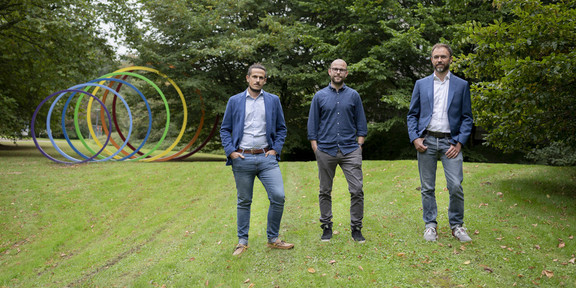International Team Achieves New Insights into Molecular Interfaces
- Research

Molecular interfaces formed between metals and molecular compounds offer great potential as components for future optoelectronic and spin electronic devices. Porphyrin molecules are a promising building block for such interfaces. Prof. Mirko Cinchetti, Dr. Giovanni Zamborlini and Henning Sturmeit from the Department of Physics at TU Dortmund University have now researched important properties of the molecule in an international research group and thus brought it closer to practical application. They recently presented their results in the renowned journal "Small".
The amount of data is growing and growing - and with it the need for new ways to be able to store this data. One possibility is to store information in molecules. These have the advantage that they always have the same structure and are therefore very reliable - if it is possible to sustainably transfer the information into the molecules. Researchers in the field of spin electronics, a research area in nanoelectronics, are working on this.
An international research group led by Prof. Mirko Cinchetti and Dr. Giovanni Zamborlini from TU Dortmund University has now gained important insights into an interesting porphyrin-metal interface. Porphyrins contribute to important functions in living systems: For example, they are found in plant chlorophyll, which enables photosynthesis, or in haemoglobin in human blood. In the research project, the scientists vapour-deposited nickel-containing porphyrin molecules - in the centre of which there is a nickel atom - onto a copper surface. They then exposed the porphyrin-copper interface to nitrogen dioxide gas. They observed that the nickel atom in the porphyrin can be reversibly switched to a higher spin state, which has never been observed at room temperature. This mechanism can be used in the future to store information in porphyrins or to develop extremely sensitive sensors to detect the toxic nitrogen dioxide.
Porphyrin-copper interface interesting for future technical applications
The researchers also discovered another useful effect: In a future application in electrical components, current would flow through the porphyrin-copper interface. In the experiment, it has now become clear that the states responsible for the current flow are not affected by the spin switching process - an important condition for being able to produce multifunctional components that specifically change a variety of physical properties through the application of external stimuli. "All this makes the porphyrin-copper interface extremely interesting for future technical applications," says Prof. Mirko Cinchetti.
The work is the result of an international collaboration between Dortmund University of Technology, Forschungszentrum Jülich, the University of Trieste, the Italian National Research Council, the University of Erlangen and the University of Graz. The experiments were mainly carried out at the ELETTRA synchrotron facility in Trieste (Italy) and the Swiss Light Source in Villigen (Switzerland). The teams led by Prof. Mirko Cinchetti and Dr. Giovanni Zamborlini (TU Dortmund University) and Dr. Vitaly Feyer and Prof. Claus M. Schneider (Forschungszentrum Jülich) were responsible for carrying out and evaluating the measurements, while Prof. Peter Puschnig (University of Graz) did the theoretical work. Prof. Cinchetti is conducting research in the project as part of his ERC Consolidator Grant. He had received the two million euro EU grant in 2016.
Link to the original publication
Contact for queries:










